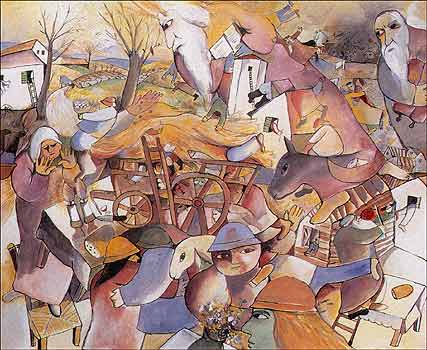Museum of Latin American Art ,
Sep 24, 2000 - Jan 14, 2001
Long Beach, CA, USA
Gurvich: A narrative walk-through of the exhibit
by Cynthia MacMullin
Israel and Jewish Identity
Gurvich's Jewish identity is essential to his creative contribution. He visited Israel on three occasions, staying for several months with his sister on the kibbutz Ramot Menashe, where many Latin American Jews had settled. He devoted himself to his work as a shepherd, which was reflected in his extensive writings, paintings and drawings. Many paintings from his Kibbutz Composition series created in the mid-1960s, are canvases populated with scenes and symbols of Jewish customs and festivals - farm dwellings, animals, kissing couples, folk dancers and a torch procession from a festival celebration. Included are images of the menorah, which symbolizes the original tree of life, the seven branches of the Tabernacle, and the seven days of Creation.
Image 5
Gurvich painted a series of joyful, lively paintings that celebrate the traditional Jewish holidays. The festivals, or feasts, are particularly important and relevant in Israel because they are linked with the sacred seasonal calendar, the cycle of sowing and harvesting crops, and the fertility of the soil. Gurvich painted in an unusually bright color palette to depict the national holidays in the rural setting of Israel-- Sukkot, Pessach, Hannukah, Shavout, and Purim. In Sukkot, Gurvich paints the summer harvest, which is related to the Jewish pilgrimage through the desert to the Promised Land. In Hannukah, the kibbutz member's midnight procession, carrying communal candlesticks or torches through the streets. Gurvich loved these processions, and was moved by their power in the rural night. These works were created in New York when he was commissioned by the art dealer Jean Aberbach to paint a series of Jewish religious themes on large canvases. This commission led him to study Jewish ritual symbolism and to explore his cultural and religious identity.
Image 6
NEW YORK URBANISM
Throughout his creative life, Gurvich paid homage to the urban landscape. It is during the last years of his career, however, that this tribute acquires the singular characteristics that culminate in his vision of New York City, where he moved from Montevideo in 1970. Gurvich painted the impact of the metropolis' fast pace and movement illuminated in reddish tones. He painted the masses, juxtaposing random objects and anonymous characters within a landscape that expressed the city's chaos. Figures and forms run and fly within a scene densely filled with billboards, traffic signals, garbage cans, skyscrapers, taxi drivers, and bustling crowds.
Image 7
In his last works, he designed a series of drawings and plans for metropolis scale sculptures entitled Projects for Monuments. Please move to the last watercolors on the moveable wall. In the series Projects for Monuments, 1971-1973, the artist creates various sculptural forms suitable for plazas and public spaces. These works echo the art of Hieronymous Bosch, Gonzalo Fonseca, Torres-García and the American artist Phillip Guston. It is very difficult to evaluate the future development of these works since they were left unfinished due to his premature death. It is clear that Gurvich showed potential as a sculptor. However, one can only speculate what might have come of this idea had he lived longer.
Image 8
The series of paintings in this final phase of Gurvich's life indicate the direction his art may have evolved, however these ideas were never realized.
|





